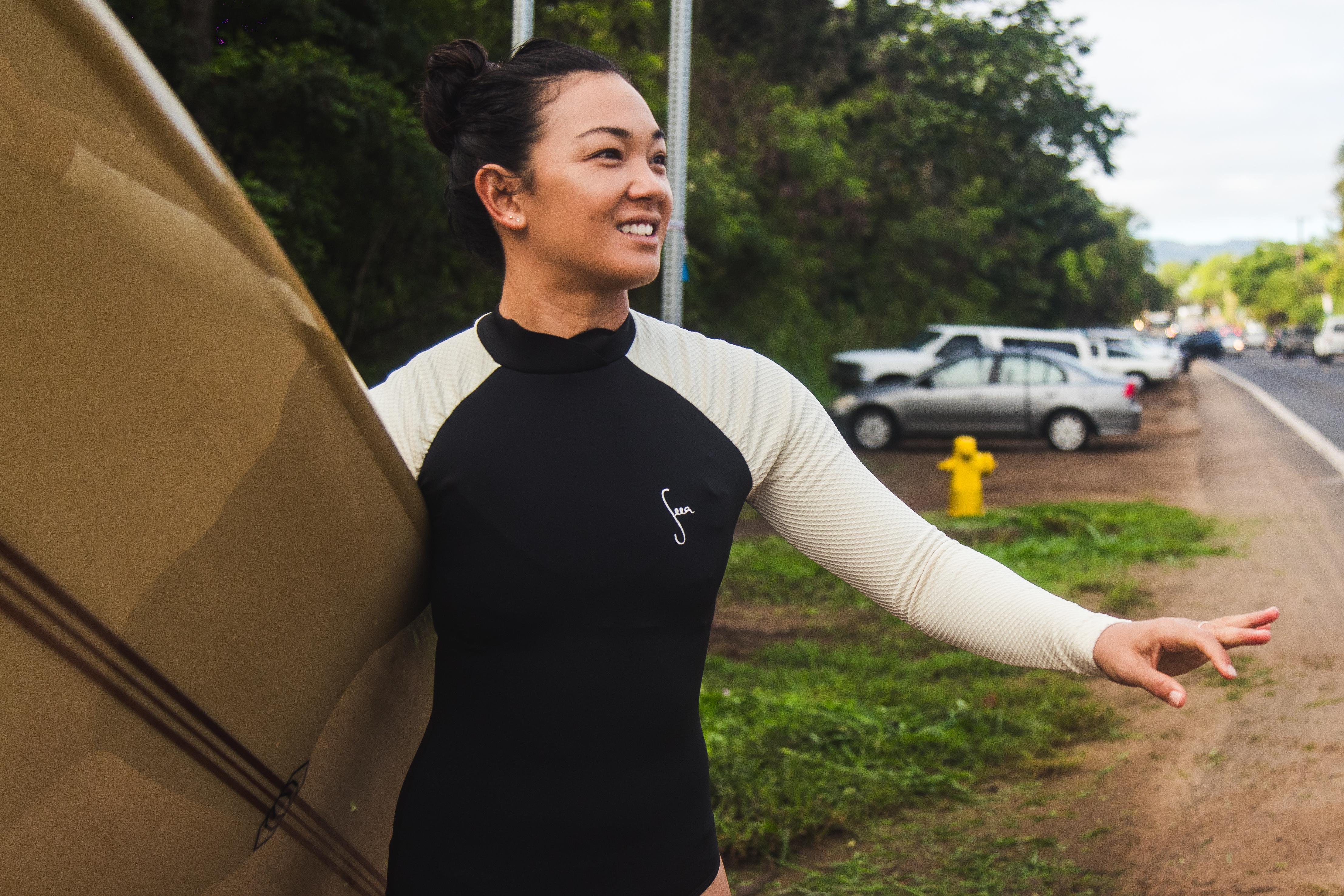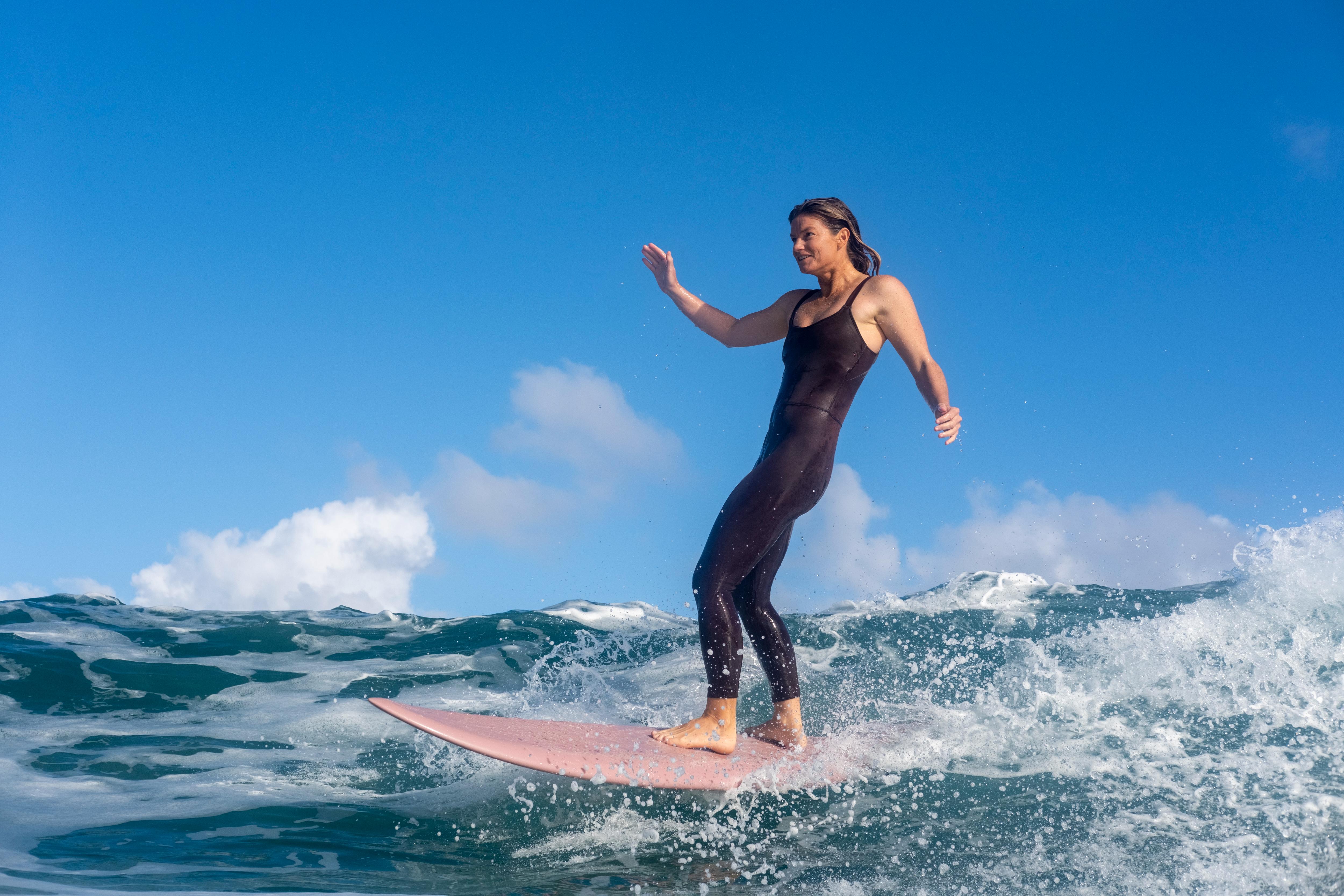Everyone should be diligent about sun protection year-round, but surfers should be especially mindful given the nature of our lifestyle.
We had a little Q&A with Dr. Melissa Kanchanapoomi Levin M.D, board certified dermatologist, fellow surfer, and founder of Entière Dermatology in NYC, who generously shared her expertise to demystify some sun-care misconceptions and give us some tips that will help you make the most informed choices to enjoy the sun safely, both in and out of the water.
For everything sun protection, check out our Sun Safe Selections collection!

(Dr. Melisa K. Levin , PC: Entière Dermatology)
Mineral or Physical sunscreen : is one more effective than the other?
Both mineral and physical sunscreens are effective at providing broad-spectrum protection against UVA and UVB rays.
Mineral sunscreens work by sitting on top of the skin and acting as a physical barrier to block and scatter UV rays while chemical sunscreens convert the UV radiation into heat.
I often say the best sunscreen is the one that you not only wear but apply enough of. Previously, many mineral sunscreens left a white chalky discoloration as they contain zinc oxide or titanium dioxide, therefore chemical sunscreens often provided better protection because enough was applied and reapplied.
However, as long as enough is applied (1 quarter size for the face and neck and 1 shot glass amount for the body) and reapplied every 2 hours, both mineral and chemical sunscreens are effective.
What is your preference?
My preference typically leans towards mineral sunscreens since I have a young toddler with sensitive skin. Mineral sunscreens tend to be more well-tolerated for sensitive skin. Due to my skin type and how my toddler is always actively climbing on me, I prefer to use what I would use on my daughter. The choice between mineral and physical sunblock ultimately depends on individual preferences, skin type, and any specific skin concerns. It's important to choose a sunscreen that you will consistently use and reapply.
How do we read the SPF on sunscreen labels ?
The SPF (Sun Protection Factor) number on sunscreen labels indicates the level of protection against UVB rays, which are primarily responsible for sunburns. The SPF number represents the amount of time you can stay in the sun without getting sunburned compared to the time it would take without sunscreen.
For example, if you normally burn after 10 minutes of sun exposure, an SPF 30 sunscreen applied correctly would theoretically allow you to stay in the sun 30 times longer (300 minutes) before burning.
How often should we reapply sunscreen when we’re surfing?
When surfing, it's important to reapply sunscreen regularly, especially after being in the water or towel drying. Water, sweat, and friction can remove sunscreen, so I recommend reapplying every two hours or more frequently if needed. Using water-resistant sunscreen formulations can also provide added protection during water activities.
Are oral sunscreen pills legitimate – is there any research that suggest they work?
No there is no such thing as an oral sunscreen. The only way to protect the skin from the UV damage is to limit UV exposure during the high UV exposure hours, routinely use and reapply FDA-approved sunscreen topical products, and optimize the use of photoprotective clothing when you are able to.
It is, however, well established that an extract called Polypodium leucotomos (PLE) has well-researched benefits in reducing UV-causing redness when taking appropriately. It’s important to emphasize that not only 1 product or intervention is entirely protective - whether that is sunscreen or PLE supplementation. Taking an oral PLE supplement is one method in protecting the skin from UV but does not replace the other preventative measures. The most notable benefit of PLE is that is it a potent antioxidant that neutralizes free radicals and can help in decreasing the photodamage process.
Are there any misconceptions about sunscreen or sun protection, in general, that you hear regularly in your practice?
Yes, there are some common misconceptions about sunscreen and sun protection that I often come across. One is the belief that higher SPF numbers provide significantly better protection.
In reality, SPF 30 and SPF 50 sunscreens offer similar protection, with SPF 30 protecting about 97% of UVB rays and SPF 50 blocking 98%.
Another misconception is that wearing sunscreen alone is enough to protect against all sun damage. While sunscreen is essential, it's important to seek shade, wear protective clothing, and use other sun protection measures alongside sunscreen for comprehensive sun protection.
Is clothing effective sun protection?
Yes, clothing is an effective form of sun protection however, not all clothing is created equal. Some fabrics offer better protection such as dense fabric, bright or dark colors, and even better UPF clothing.
For example, a white t-shirt provides SPF of approximately 7 while a denim shirt provides an SPF of about 1700. For more effective sun protection, using clothing with an ultraviolet (UPF) number on the label is ideal. Wearing clothing that covers the skin acts as a physical barrier between the sun's rays and the skin. It is recommended to wear lightweight, long-sleeved shirts, long pants or leggings, and wide-brimmed hats for added protection.
 {The Swamis is rated
UPF 30+ to 50+. It is ideal for long surf days out in the sun. Photo by Mariah Brink}
{The Swamis is rated
UPF 30+ to 50+. It is ideal for long surf days out in the sun. Photo by Mariah Brink}
What exactly is UPF rating ?
UPF stands for Ultraviolet Protection Factor. It measures the effectiveness of fabric in blocking UV radiation. A higher UPF rating indicates greater sun protection. For example, clothing with a UPF rating of 50+ blocks over 98% of UV rays. It's important to look for clothing with a UPF rating when choosing sun-protective garments.
 {The Gaviotas surf suit covers the arms for all day sun protection. Photo by Mike Ito}
{The Gaviotas surf suit covers the arms for all day sun protection. Photo by Mike Ito}
Are there colors or specific fabrics that offer better sun protection than others? What’s the best color to wear surfing?
Darker colors generally provide better sun protection as they absorb or block more UV radiation compared to lighter colors. Tightly woven fabrics offer better protection compared to loosely woven ones, as they create a denser barrier against UV rays. Fabrics treated with UV-absorbing or UV-blocking agents can also enhance sun protection.
When surfing, it's advisable to choose darker colors, such as navy blue or black, as they tend to provide better sun protection by absorbing more UV radiation. Additionally, consider wearing sun-protective rash guards or wetsuits designed with UPF-rated fabrics for extended coverage and added sun protection.

{Leah Dawson wears the full coverage on her legs in the Penelope body suit. Photo by Keoki Saguido}
Thanks again to Dr. Levin for sharing her knowledge with us.
You can find Dr. Levin on Instagram.
Planning a surf-trip or looking to more sun-protective pieces into your suit rotation? Check out our Sun Safe Selection of fuller-coverage UPF 30-50+ Seea styles for optimal sun protection - all in one place.
And be sure to follow Dr. Levin's advice below!









